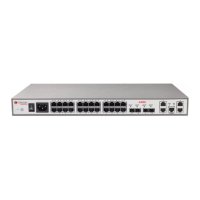A10E/A28E/A28F Configuration Guide
bandwidth will be occupied. Therefore, network performance is reduced and unicast packet
cannot be forwarded. In addition, the communication between devices may be interrupted.
Configuring storm control on Layer 2 devices can prevent broadcast storm occurring when
broadcast packets increase sharply in the network. And therefore, ensure the unicast packets
can be properly forwarded.
After storm control is enabled, the interface will automatically discard the received packets. If
storm control is disabled or if the number of received broadcast packets does not reach the
pre-configured threshold, the broadcast packets are broadcasted to other interfaces of the
switch properly.
6.6.1 Preparing for configurations
Scenario
Configuring storm control in the Layer 2 network can prevent broadcast storm occurring
when broadcast packets increase sharply in the network. And therefore, ensure the unicast
packets can be properly forwarded.
Broadcast traffic may exist in following forms, so you need to limit the bandwidth for them
on Layer 2 devices.
Unknown unicast traffic: the unicast traffic whose MAC destination address is not in
MAC address table. It is broadcasted by Layer 2 devices.
Unknown multicast traffic: the multicast traffic whose MAC destination address is not in
MAC address table. Generally, it is broadcasted by Layer 2 devices.
Broadcast traffic: the traffic whose MAC destination address is a broadcast MAC
address. It is broadcasted by Layer 2 devices.
Prerequisite
Connect the interface properly, and configure it to make it physically Up.
6.6.2 Default configurations of storm control
The default configuration of storm control is as below.
Broadcast storm control status
Multicast and unknown unicast storm control status
6.6.3 Configuring storm control
Configure storm control for the A10E/A28E as below.

